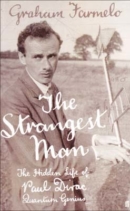by Graham Farmelo, Faber. Hardback ISBN 9780571222780, £22.50.

On 13 November 1995 the president of the Royal Society, Sir Michael Atiyah, unveiled a plaque in the nave of Westminster Abbey in London commemorating the life of Paul Dirac. Speaking at the ceremony, Stephen Hawking summed up Dirac’s life: “Dirac has done more than anyone this century, with the exception of Einstein, to advance physics and change our picture of the universe.” The plaque depicted Dirac’s equation in a compact relativistic form and the man himself would no doubt have appreciated its terse style. At the time of his passing in 1984 Dirac ranked among the greatest physicists of all time. With the publication of Graham Farmelo’s book The Strangest Man, we have an account of Dirac’s life that is a tour de force.
Dirac’s Swiss father, Charles, taught French at the Merchant Venturers’ Technical College in Bristol and married Florence Holten in 1899. They had three children, Beatrice, Reginald (who committed suicide in 1924) and Paul, who was born on 8 August 1902 – the same year that Einstein started work at the patent office in Bern and Planck initiated the quantum theory of matter and light. This was the start of the modern era in which classical physics was revolutionized by two great advances – special relativity and quantum mechanics.
Dirac’s early years were overshadowed by his domineering father and a browbeaten, needy mother. “I never knew love nor affection when I was a child,” Dirac once remarked. Certainly, his difficult childhood seems to have deeply influenced the development of his “strange” character. Farmelo also explores another explanation for Dirac’s introversion, literality, rigid behaviour patterns and egocentricity: perhaps Dirac, like his father, was autistic. Nonetheless, in his thirties, Dirac met and married Manci Balázs, an extroverted and passionate woman – his “antiparticle”. Farmelo’s candid and sympathetic account of the couple’s improbable life together makes compelling reading. Yet, according to Farmelo, Dirac only cried once in his life, and that was when Einstein died.
Dirac’s seminal contribution to physics was the unification of Heisenberg and Schrödinger’s quantum mechanics with Einstein’s special relativity, which allowed him to write down a relativistic equation for the electron – the famous Dirac equation. With it he revealed the concept of spin and predicted the existence of antiparticles, subsequently discovered in studies of cosmic rays. In 1933, aged 31, he shared the Nobel prize with Schrödinger.
Dirac was also the creator of quantum electrodynamics and one of the chief architects of quantum-field theory. For him, the beauty of mathematical reasoning and physical argument were instruments for discovery that, if used fearlessly, would lead to unexpected but valid conclusions. Perhaps the single contribution that best illustrates Dirac’s courage is his work on the magnetic monopole, the existence of which would explain the quantization of electric charge. The monopole’s story is still far from complete and more revelations could be forthcoming.
Farmelo succeeds brilliantly in unifying all of the shadowy and contradictory perspectives of Dirac’s character with his life as a scientific genius, and creates a complete picture of the man who played a leading role in the growth of modern physics. The book reveals how Dirac, although aloof and unworldly, was deeply affected by the turbulent and troubled history of the 20th century.





